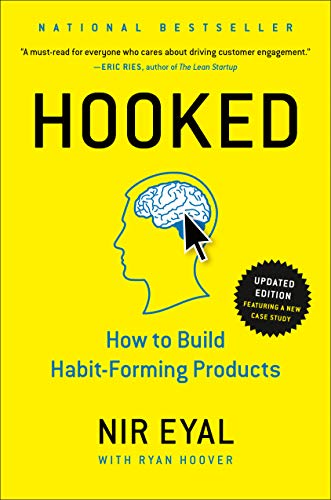What makes you check your phone 100 times per day? Why do you always use Google instead of Bing? Or why do lay awake at night, scrolling through your Instagram feed, even when you know you should be sleeping?
In Hooked: How to Build Habit Building Products, Nir Eyal provides the exact model that many digital products use to make us want to use it. According to the author, all these apps use the Hook model — finding ways to intertwine their usage into our daily lives, routines and habits.
The book has been praised by many well-known entrepreneurs, such as Eric Ries (the Lean Startup), Dave McClure (500 Startups) and Boris Veldhuijzen van Zanten (The Next Web). So clearly, Hooked is a great read for company founders, particularly when you want to dive into the psychology of user interaction and making your app or product ‘stick’. So if you want a quick overview of the model without needing to read the entire book, you can find a summary and my book review of Hooked below.
Highlights of Hooked: The Hook Model
In summary, the book Hooked provides a model to ‘hook’ users. It’s a model to make them come again and again.
When you read this, you may think that the intention of using the hook model is making users addicted. But after some correspondence with the author, I realized that addiction in this sense, is a combination of factors, of which the product (or drug, or whatever it is) is just one.
As you can see in the image below, the Hook model consists of four different steps. The Trigger, the Action, the Variable Reward, and the Investment. Specifically, users are:
- Triggered to open your app or product;
- After which they perform an action within the product;
- This results in a variable reward;
- And finally they make an investment to improve their experience.

This is a simple example of the Hooked model; in the book, the author expands on each different section — which I will do here shortly too.
Trigger
The Hook Model starts with the trigger. In this example, the trigger was a notification on your phone. According to Eyal, the trigger can be both internal and external.
In this case, the Instagram notification is an external trigger. Similarly, an advertisement, email, or even word-of-mouth marketing may be the external trigger you need as a user to start engaging with a product.
Alternatively, a trigger can be internal. This is the case when users have already gone through the Hooked model (and the circle in the image above) once or several times. You yourself trigger a need or want to open the Instagram app, without any external interference.
Action
What is the action you want a user to take in/with your product? The goal of the product team is to (among many other things) make the action as easy as possible.
In both this model and life in general, an action consists of three aspects: motivation, ability, and trigger. This is also called the Fogg Behavioral Model, represented as B = MAT. Take a simple example: the behavior (or action) of doing groceries. If you do groceries you need to be 1) motivated to do so, 2) able to do so, and 3) you need a certain trigger. So if it’s Friday night and you don’t feel like going outside (motivation), if your car has stopped working (ability) or if you have a full fridge (trigger), you’re not very likely to go to the supermarket.
Variable Reward
Interestingly, a reward a user gets from a product should not be the same every time. Just like with gambling, there should be a variable reward — sometimes you get X, sometimes you get Y, or perhaps sometimes you get nothing at all.
Preferably, a product has so-called “infinite variability”. You can find this infinite variability in the un-ending scroll of products like Instagram, Reddit, Pinterest or even certain news sites. You never know what you can expect, making the product new and exciting, every time you open it.
Investment
Users making an investment into your product helps them get back to the product in several ways. First, investing in the product usually improves the product itself. For instance, LinkedIn adding more information to their profile makes the entire platform more useful for other users.
In addition, one bias (or fallacy) we all face is the sunk cost fallacy. I’ve mentioned cognitive biases before, and the sunk cost fallacy is the idea that when you put more effort or energy into something, it becomes more difficult to let it go or step away. In this sense, a user’s investment in your product will make it more likely for him/her to stick with your product, even if there are better alternatives on the market.
Applying the Lessons of Hooked
Whenever you read a business book, it’s important to look at how to apply it to your specific case. Luckily, Nir Eyal provides several questions and small to-do’s at the end of every chapter that you can use to apply the Hooked model to your product.
Specifically, you could look at your product (or service) and answer questions such as:
- Which internal trigger does your user experience most frequently?
- Which resources are limiting your users’ ability to accomplish the tasks [or actions] that will become habits?
- What are 3 ways your product might increase users’ search for variable rewards?
- What ‘bit of work’ [or investment] are your users doing to increase their likelihood of returning?
These are just a couple of questions from the book; if you truly want to apply this model to your product, I recommend reading (and answering) all of them.
Hooked Book Review by an entrepreneur
In my opinion, the Hooked model and book is particularly relevant for entrepreneurs and company founders building B2C digital products. Whether you’re building a new kind of social media platform, a videogame, an app to order groceries, or something else, the Hooked model can help you to increase the chances of your users returning to your product. That said, the ideas in the book are useful for B2B products too, but it really depends on your product whether the model is relevant.
While the book’s theory isn’t entirely ground-breaking, I think it’s very useful to have a model which you can apply to the interactions of your users with your product. As founders or product managers, we often talk about a customer journey, which is a good way of looking at it. However, by using the Hooked model, you may find new improvements you can make to that customer journey, that you wouldn’t have found otherwise.
This particularly applies to the ‘variable reward’ and ‘investment’ steps of the Hooked circle. Most people designing a product know the trigger leading to a user interaction, and the action they want their users to take. However, creating a variable reward, and ensuring that a user goes beyond ‘just interacting’ to actually investing in the product, is something that often comes as an after-thought. Applying this model to your product, makes you really think about the different ways and new functionalities you could implement to enable these two steps.
Overall, I found the book quite enjoyable. As is usually the case with books that offer a model, it is not entirely necessary to read the whole book. By reading this article, you already have a fair understanding of the model, and otherwise you could simply read some extra material on the author’s blog. However, reading the entire book does make everything sink in better, and if you want to apply the model directly to your product, it may be useful to get yourself a copy.
Note that I only write about books that I’ve actually read and products I’ve actually used — this post contains an affiliate link from Amazon; as an Amazon Associate I may earn a small commission if you click and buy the product in question.


Recent Comments